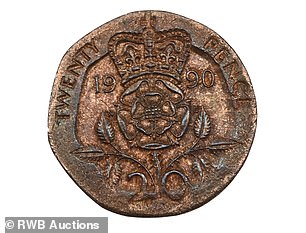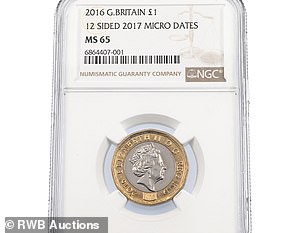- The coin is missing the £2 denomination on the reverse, making it ‘ultra rare’
- It was estimated to fetch between £600 and £800
- Other error coins also went for way beyond estimates

Worth a mint: A £2 Lord Kitchener coin minted in 2014 has sold for £1,000 at an auction
A rare £2 Lord Kitchener coin minted in 2014 has sold for £1,000 at an auction today.
It was estimated the coin would fetch between £600 to £800.
It was bought by an American bidder at the live auction by RWB this afternoon.
The coin is missing the words ‘Two Pounds’ on the reverse, an ultra rare error which has been authenticated by the Royal Mint.
This £2 coin was issued in 2014 to mark 100 years since the outbreak of the First World War.
It features a ‘Your Country Needs You’ recruiting poster with an image of Field Marshall Kitchener on the obverse.
There were 5,720,000 of these coins that entered circulation, meaning it could be quite easy to stumble across one in your change.
Without the error, the coin is not particularly significant.
However, a small unknown number of the coins could have entered circulation without the ‘Two Pounds’ denomination on the reverse, meaning the hunt is on for more to be discovered.
There have only been two reports of these ‘error’ coins being found in circulation according to Change Checker.
Lockdales Auctioneers officiated the sale of one back in March 2020 to the value of £500. So the amount these coins fetch is growing £1,000.
1990 20p error coin
A 1990 error 20p coin struck on a bronze 1p blank fetched £200 at the auction.
It comes with a signed letter from the Information and Research Manager at The Royal Mint Museum which confirms the details of this rare error coin.
It reads: ‘The piece is of the incorrect composition for a twenty pence piece, underweight, and features slightly rounded edges consistent with the blank being unsuitable in size for the collar in which it was struck.
‘It appears in this instance that a bronze blank, most likely intended for a 1p piece, has been struck between 20p dies.’


Errors: The 20p left was cast on a bronze blank probably intended for a 1p and the £1 coin right has two differing years stamped on it
2016 £1 error coin
A 2016 one pound coin sold for £200. It was estimated to fetch £80.
The coin has an error which features two dates – 2016 on the obverse and 2017 micro engraved on the reverse.
The tiny micro text around the rim, visible under magnification shows ‘2017’ rather than 2016 as would be expected. The error was confirmed by the Royal Mint in 2017.
Change Checker says there is currently no indication as to how many of these error coins have been struck.

A fabled 50p Kew Gardens coin has sold for £160
2009 50p Kew Gardens coin
Also noteworthy at the auction three fabled 2009 Kew Gardens 50p coins up for grabs.
The Kew Gardens 50p is one of the most coveted coins, due to its scarcity in circulation and as a commemorative coin. It ranks number one on Change Checker’s 50p scarcity index.
With just 210,000 minted in 2009, these coins can sell north of £150 and as such, the majority have been hoovered out of circulation and are in the hand of collectors.
The most interesting at the auction was a circulating version with an estimate of between £80-£120. It sold for £160.
Two others are uncirculated versions. One has a mintage of 10,000 and sold for £240 and the other has a mintage of 50,000, which sold for £220. Both come in a special presentation pack.
The coin features a design by Christopher Le Brun on the obverse celebrating the Royal Botanical Gardena, depicting the pagoda at Kew with a decorative vine twining in and around the tower and with the years ‘1759’ and 2002′ either side of the word ‘Kew’.
This coin was first released in 2009 to celebrate 250 years of the iconic West London landmark.



